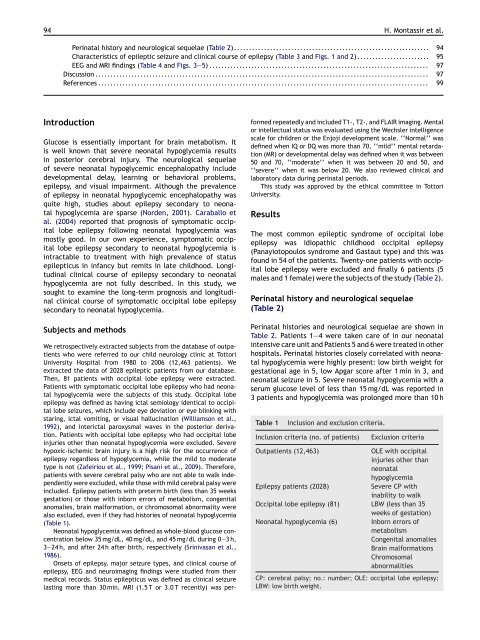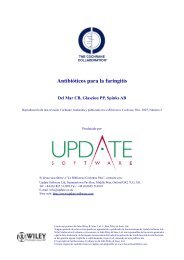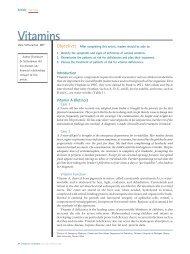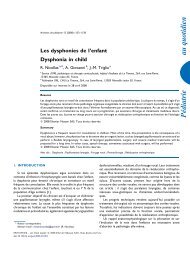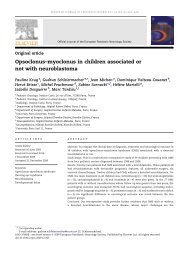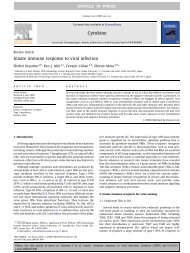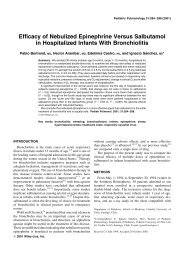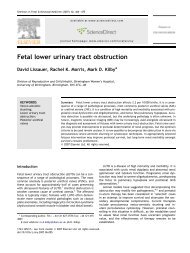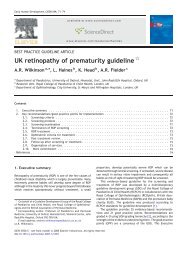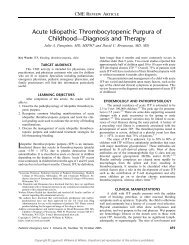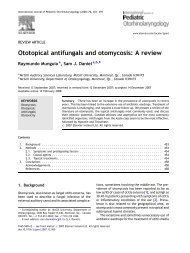Long term prognosis of symptomatic occipital lobe epilepsy ... - sepeap
Long term prognosis of symptomatic occipital lobe epilepsy ... - sepeap
Long term prognosis of symptomatic occipital lobe epilepsy ... - sepeap
Create successful ePaper yourself
Turn your PDF publications into a flip-book with our unique Google optimized e-Paper software.
94 H. Montassir et al.<br />
Perinatal history and neurological sequelae (Table 2)................................................................. 94<br />
Characteristics <strong>of</strong> epileptic seizure and clinical course <strong>of</strong> <strong>epilepsy</strong> (Table 3 and Figs. 1 and 2)........................ 95<br />
EEG and MRI findings (Table 4 and Figs. 3—5) ......................................................................... 97<br />
Discussion ............................................................................................................... 97<br />
References .............................................................................................................. 99<br />
Introduction<br />
Glucose is essentially important for brain metabolism. It<br />
is well known that severe neonatal hypoglycemia results<br />
in posterior cerebral injury. The neurological sequelae<br />
<strong>of</strong> severe neonatal hypoglycemic encephalopathy include<br />
developmental delay, learning or behavioral problems,<br />
<strong>epilepsy</strong>, and visual impairment. Although the prevalence<br />
<strong>of</strong> <strong>epilepsy</strong> in neonatal hypoglycemic encephalopathy was<br />
quite high, studies about <strong>epilepsy</strong> secondary to neonatal<br />
hypoglycemia are sparse (Norden, 2001). Caraballo et<br />
al. (2004) reported that <strong>prognosis</strong> <strong>of</strong> <strong>symptomatic</strong> <strong>occipital</strong><br />
<strong>lobe</strong> <strong>epilepsy</strong> following neonatal hypoglycemia was<br />
mostly good. In our own experience, <strong>symptomatic</strong> <strong>occipital</strong><br />
<strong>lobe</strong> <strong>epilepsy</strong> secondary to neonatal hypoglycemia is<br />
intractable to treatment with high prevalence <strong>of</strong> status<br />
epilepticus in infancy but remits in late childhood. <strong>Long</strong>itudinal<br />
clinical course <strong>of</strong> <strong>epilepsy</strong> secondary to neonatal<br />
hypoglycemia are not fully described. In this study, we<br />
sought to examine the long-<strong>term</strong> <strong>prognosis</strong> and longitudinal<br />
clinical course <strong>of</strong> <strong>symptomatic</strong> <strong>occipital</strong> <strong>lobe</strong> <strong>epilepsy</strong><br />
secondary to neonatal hypoglycemia.<br />
Subjects and methods<br />
We retrospectively extracted subjects from the database <strong>of</strong> outpatients<br />
who were referred to our child neurology clinic at Tottori<br />
University Hospital from 1980 to 2006 (12,463 patients). We<br />
extracted the data <strong>of</strong> 2028 epileptic patients from our database.<br />
Then, 81 patients with <strong>occipital</strong> <strong>lobe</strong> <strong>epilepsy</strong> were extracted.<br />
Patients with <strong>symptomatic</strong> <strong>occipital</strong> <strong>lobe</strong> <strong>epilepsy</strong> who had neonatal<br />
hypoglycemia were the subjects <strong>of</strong> this study. Occipital <strong>lobe</strong><br />
<strong>epilepsy</strong> was defined as having ictal semiology identical to <strong>occipital</strong><br />
<strong>lobe</strong> seizures, which include eye deviation or eye blinking with<br />
staring, ictal vomiting, or visual hallucination (Williamson et al.,<br />
1992), and interictal paroxysmal waves in the posterior derivation.<br />
Patients with <strong>occipital</strong> <strong>lobe</strong> <strong>epilepsy</strong> who had <strong>occipital</strong> <strong>lobe</strong><br />
injuries other than neonatal hypoglycemia were excluded. Severe<br />
hypoxic-ischemic brain injury is a high risk for the occurrence <strong>of</strong><br />
<strong>epilepsy</strong> regardless <strong>of</strong> hypoglycemia, while the mild to moderate<br />
type is not (Zafeiriou et al., 1999; Pisani et al., 2009). Therefore,<br />
patients with severe cerebral palsy who are not able to walk independently<br />
were excluded, while those with mild cerebral palsy were<br />
included. Epilepsy patients with pre<strong>term</strong> birth (less than 35 weeks<br />
gestation) or those with inborn errors <strong>of</strong> metabolism, congenital<br />
anomalies, brain malformation, or chromosomal abnormality were<br />
also excluded, even if they had histories <strong>of</strong> neonatal hypoglycemia<br />
(Table 1).<br />
Neonatal hypoglycemia was defined as whole-blood glucose concentration<br />
below 35 mg/dL, 40 mg/dL, and 45 mg/dL during 0—3 h,<br />
3—24 h, and after 24 h after birth, respectively (Srinivasan et al.,<br />
1986).<br />
Onsets <strong>of</strong> <strong>epilepsy</strong>, major seizure types, and clinical course <strong>of</strong><br />
<strong>epilepsy</strong>, EEG and neuroimaging findings were studied from their<br />
medical records. Status epilepticus was defined as clinical seizure<br />
lasting more than 30 min. MRI (1.5 T or 3.0 T recently) was performed<br />
repeatedly and included T1-, T2-, and FLAIR imaging. Mental<br />
or intellectual status was evaluated using the Wechsler intelligence<br />
scale for children or the Enjoji development scale. ‘‘Normal’’ was<br />
defined when IQ or DQ was more than 70, ‘‘mild’’ mental retardation<br />
(MR) or developmental delay was defined when it was between<br />
50 and 70, ‘‘moderate’’ when it was between 20 and 50, and<br />
‘‘severe’’ when it was below 20. We also reviewed clinical and<br />
laboratory data during perinatal periods.<br />
This study was approved by the ethical committee in Tottori<br />
University.<br />
Results<br />
The most common epileptic syndrome <strong>of</strong> <strong>occipital</strong> <strong>lobe</strong><br />
<strong>epilepsy</strong> was idiopathic childhood <strong>occipital</strong> <strong>epilepsy</strong><br />
(Panayiotopoulos syndrome and Gastaut type) and this was<br />
found in 54 <strong>of</strong> the patients. Twenty-one patients with <strong>occipital</strong><br />
<strong>lobe</strong> <strong>epilepsy</strong> were excluded and finally 6 patients (5<br />
males and 1 female) were the subjects <strong>of</strong> the study (Table 2).<br />
Perinatal history and neurological sequelae<br />
(Table 2)<br />
Perinatal histories and neurological sequelae are shown in<br />
Table 2. Patients 1—4 were taken care <strong>of</strong> in our neonatal<br />
intensive care unit and Patients 5 and 6 were treated in other<br />
hospitals. Perinatal histories closely correlated with neonatal<br />
hypoglycemia were highly present: low birth weight for<br />
gestational age in 5, low Apgar score after 1 min in 3, and<br />
neonatal seizure in 5. Severe neonatal hypoglycemia with a<br />
serum glucose level <strong>of</strong> less than 15 mg/dL was reported in<br />
3 patients and hypoglycemia was prolonged more than 10 h<br />
Table 1<br />
Inclusion and exclusion criteria.<br />
Inclusion criteria (no. <strong>of</strong> patients)<br />
Exclusion criteria<br />
Outpatients (12,463)<br />
OLE with <strong>occipital</strong><br />
injuries other than<br />
neonatal<br />
hypoglycemia<br />
Epilepsy patients (2028)<br />
Severe CP with<br />
inability to walk<br />
Occipital <strong>lobe</strong> <strong>epilepsy</strong> (81) LBW (less than 35<br />
weeks <strong>of</strong> gestation)<br />
Neonatal hypoglycemia (6) Inborn errors <strong>of</strong><br />
metabolism<br />
Congenital anomalies<br />
Brain malformations<br />
Chromosomal<br />
abnormalities<br />
CP: cerebral palsy; no.: number; OLE: <strong>occipital</strong> <strong>lobe</strong> <strong>epilepsy</strong>;<br />
LBW: low birth weight.


